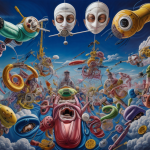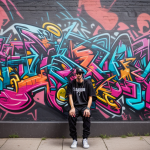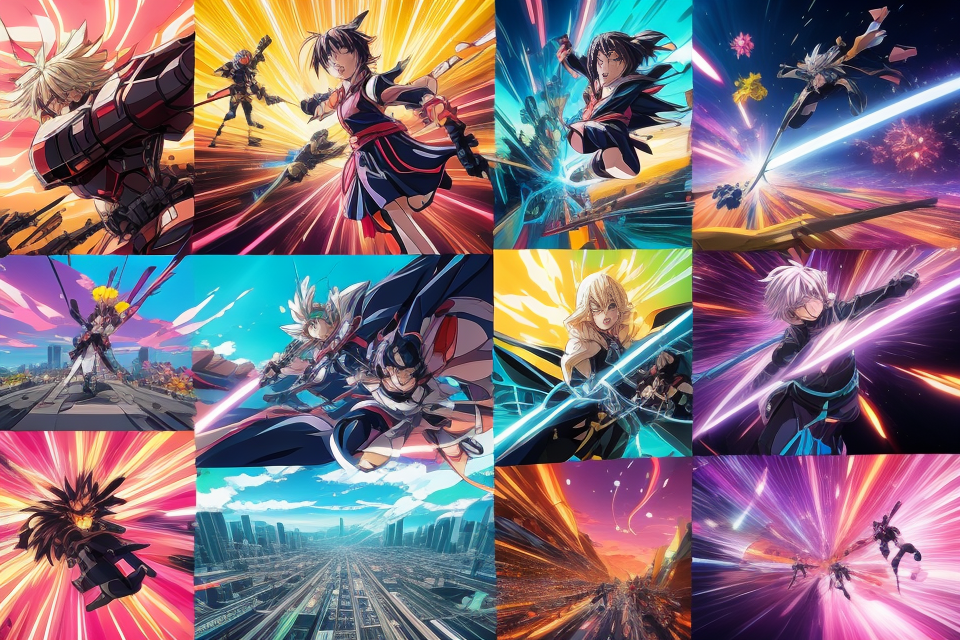Anime has been entertaining audiences for decades, transporting us to fantastical worlds and introducing us to unique characters. But have you ever wondered how these beloved shows are made? From concept to creation, the process of making anime is a complex and fascinating one. In this guide, we’ll take a deep dive into the world of anime production, exploring each step of the process in detail. Whether you’re a die-hard fan or simply curious about the creative process, this is the ultimate resource for understanding how anime is made. So, buckle up and get ready to discover the magic behind your favorite animated shows!
The Concept and Planning Phase
Idea Generation
When it comes to creating an anime, the first step is to come up with a concept that will serve as the foundation for the entire project. This is where the idea generation process comes in. The idea generation process is crucial because it sets the tone for the entire production. Here are some ways that anime creators come up with ideas for their projects:
- Inspiration from manga, novels, and real-life events: Many anime creators look to existing manga and novels for inspiration. They may also draw inspiration from real-life events or phenomena. For example, the popular anime “Death Note” was inspired by the concept of a notebook that could kill anyone whose name was written in it.
- Brainstorming sessions among creators and producers: Another way that anime creators come up with ideas is through brainstorming sessions. These sessions involve a group of creators and producers who get together to discuss potential concepts and ideas. They may throw out ideas and build on each other’s thoughts until they come up with a concept that they all agree on.
- Narrowing down ideas and selecting the most viable concepts: Once the creators and producers have come up with a list of potential concepts, they will need to narrow down their choices. They will consider factors such as the target audience, the budget, and the feasibility of the concept. They will also consider which concept will be the most engaging and entertaining for the audience.
Overall, the idea generation process is a crucial step in the anime production process. It sets the tone for the entire project and can make or break the success of the anime. By drawing inspiration from various sources and collaborating with other creators and producers, anime creators can come up with concepts that are both unique and engaging.
Scriptwriting
Scriptwriting is a crucial aspect of anime production, as it lays the foundation for the story’s plot, characters, and dialogue. The script is created by the writer and serves as a blueprint for the entire production process.
- Outlining the storyline and creating character profiles
- An outline is a detailed summary of the story’s plot points, including major events and character arcs. It helps the writer keep track of the story’s structure and ensure that it flows smoothly.
- Character profiles provide background information on each character, including their personality, motivations, and relationships with other characters. This information helps the animators and voice actors create accurate and consistent portrayals of the characters throughout the series.
- Developing a story bible to maintain consistency
- A story bible is a document that outlines the major events, settings, and characters in the story. It helps ensure that the story remains consistent throughout the production process and prevents contradictions or inconsistencies from arising.
- Writing the script with attention to pacing and dialogue
- Pacing refers to the speed at which the story unfolds, and it is essential to maintain a consistent pace throughout the series. A well-paced story keeps the audience engaged and invested in the characters and plot.
- Dialogue is another crucial aspect of scriptwriting, as it reveals the characters’ personalities, motivations, and emotions. Good dialogue should be natural, engaging, and consistent with each character’s personality.
The Pre-Production Phase
Character Design and Concept Art
Creating the visual appearance of characters and settings is a crucial aspect of anime production. The character design and concept art phase involves establishing the art style and color palette, as well as designing keyframes and backgrounds for animation.
Here are some key steps involved in the character design and concept art phase:
Establishing the Art Style and Color Palette
The first step in character design and concept art is to establish the art style and color palette. This involves deciding on the overall aesthetic of the anime, including the level of detail, the use of shading and highlights, and the color scheme. The art style can vary greatly from one anime to another, from a more realistic and grounded style to a more stylized and exaggerated style.
Once the art style and color palette have been established, the character designer can begin to create the visual appearance of the characters.
Designing Keyframes and Backgrounds for Animation
Another important aspect of character design and concept art is designing keyframes and backgrounds for animation. Keyframes are the basic drawings that are used as a reference for the animators to create the movement and action of the characters. The backgrounds are the settings in which the characters move and interact.
Designing keyframes and backgrounds requires a good understanding of the story and the characters, as well as the technical aspects of animation. The designer must consider the movement and action of the characters, as well as the overall composition of the scene.
Creating the Visual Appearance of Characters and Settings
The character designer is responsible for creating the visual appearance of the characters and settings in the anime. This involves designing the characters’ bodies, faces, clothing, and accessories, as well as the settings in which they move and interact.
The character designer must consider the personalities and roles of the characters, as well as the story and setting of the anime, when designing their appearance. The designer must also ensure that the characters and settings are visually appealing and consistent with the established art style and color palette.
Overall, the character design and concept art phase is a crucial aspect of anime production, as it sets the visual tone and style for the entire series. A well-designed character and setting can greatly enhance the viewer’s experience and make the anime more engaging and memorable.
Voice Acting and Sound Design
Casting Voice Actors for Each Character
Casting the right voice actors for each character is crucial to the success of an anime production. The voice actors must be able to bring the characters to life and portray their personalities accurately. The casting process involves selecting actors who have the necessary skills and who are suitable for the roles they will be playing. The director and producers work together to select the best actors for each role, taking into consideration factors such as the actor’s experience, vocal range, and physical appearance.
Recording Dialogue and Sound Effects
Once the voice actors have been cast, the next step is to record their dialogue and sound effects. This process involves setting up a recording studio and using high-quality equipment to capture the actors’ voices. The dialogue is recorded first, with the actors reading their lines in front of a microphone. The sound effects are then added to the dialogue to enhance the overall audio experience. This process requires careful attention to detail to ensure that the sound effects are synchronized with the dialogue and the animation.
Integrating Music and Sound Effects into the Narrative
After the dialogue and sound effects have been recorded, the next step is to integrate the music and sound effects into the narrative. This process involves selecting the right music and sound effects to enhance the mood and atmosphere of the scene. The music and sound effects must be carefully timed to match the action on screen and to create a seamless audio experience. The director and sound engineers work together to ensure that the music and sound effects complement each other and enhance the overall quality of the production.
The Production Phase
Animation and Keyframe Production
Creating rough sketches and refining the animation
In the animation and keyframe production phase, the first step is to create rough sketches of each scene. These sketches are used as a reference for the animators, who then refine the animation by adding more details and making adjustments to the movements and expressions of the characters. This process can involve several iterations until the animation is deemed ready for the next stage.
Developing keyframes for each scene
Once the rough sketches have been created and refined, the next step is to develop keyframes for each scene. Keyframes are the individual drawings that make up the animation, and they are used to create the illusion of movement. The animators will carefully plan out each keyframe, taking into account the movements of the characters, the background, and any special effects that need to be included.
Timing the animation to match the dialogue and sound effects
Once the keyframes have been developed, the animators will then time the animation to match the dialogue and sound effects. This involves synchronizing the movements of the characters with the dialogue and sound effects, so that the animation matches the audio in a seamless and natural way. This process can be quite time-consuming, but it is essential for creating a high-quality anime production.
Quality Control and Editing
The process of quality control and editing is a crucial step in the anime production process. This stage involves reviewing the animation for consistency and errors, making revisions and corrections as needed, and ensuring that the final product meets quality standards.
Reviewing the Animation for Consistency and Errors
During this stage, the animation team will thoroughly review the entire project to ensure that it meets the required standards. This includes checking for any errors or inconsistencies in the animation, such as continuity errors or incorrect character designs. The team will also review the audio and visual effects to ensure that they are properly synced and integrated into the animation.
Making Revisions and Corrections as Needed
If any errors or inconsistencies are found during the review process, the animation team will make the necessary revisions and corrections. This may involve re-animating certain scenes or editing the audio and visual effects to ensure that they are properly integrated into the animation.
Ensuring the Final Product Meets Quality Standards
Once all revisions and corrections have been made, the animation team will conduct a final quality check to ensure that the final product meets the required standards. This includes checking for any remaining errors or inconsistencies, as well as ensuring that the animation is visually appealing and engaging.
Overall, the process of quality control and editing is a critical step in the anime production process. It ensures that the final product is of the highest quality and meets the required standards, making it an essential part of the overall production process.
The Post-Production Phase
Dubbing and Subtitling
Dubbing the Animation in Multiple Languages
Dubbing is the process of replacing the original audio of an anime with a translated version in another language. This step is crucial for making the anime accessible to a wider audience. Dubbing requires careful attention to detail to ensure that the dialogue is synchronized with the animation. The process of dubbing involves selecting a talented team of voice actors who can provide a perfect voice match for the original Japanese voices.
Adding Subtitles for Viewers who Prefer Reading
Subtitles are a textual representation of the dialogue in the anime. They are essential for viewers who prefer reading over listening or for those who do not understand the original language. Adding subtitles requires a skilled team of translators who can accurately translate the dialogue into the target language. The subtitles must be timed accurately to match the dialogue and appear on the screen at the appropriate moment.
Synchronizing the Dialogue with the Animation
Synchronizing the dialogue with the animation is a critical step in the dubbing and subtitling process. It ensures that the characters’ lips and mouth movements match the dialogue, creating a seamless viewing experience for the audience. This process requires a skilled team of editors who can accurately sync the dialogue with the animation, taking into account factors such as the pace of speech, tone, and timing.
In summary, dubbing and subtitling are crucial steps in the post-production phase of anime production. They ensure that the anime is accessible to a wider audience and provide a seamless viewing experience for the audience.
Distribution and Marketing
- Partnering with streaming platforms and broadcasters
- Securing deals with popular streaming services and television networks to reach a wider audience
- Ensuring the anime is available in various regions and languages to cater to international fans
- Promoting the anime through trailers, merchandise, and social media
- Creating visually appealing trailers to generate hype and attract new viewers
- Developing merchandise such as figurines, clothing, and accessories to engage fans and create additional revenue streams
- Utilizing social media platforms to share behind-the-scenes content, interact with fans, and build a strong online presence
- Engaging with fans and building a community around the anime
- Organizing fan events, conventions, and screenings to connect with dedicated fans and foster a sense of belonging
- Creating official fan clubs and forums to facilitate discussions and encourage fan-generated content
- Responding to fan feedback and incorporating suggestions to improve the anime and retain viewer interest
The Future of Anime Production
Emerging Technologies and Trends
Advancements in Animation Software and Techniques
One of the most significant advancements in the anime production industry is the use of advanced animation software and techniques. These technologies have made it possible for animators to create more complex and detailed scenes, as well as streamline the production process. Some of the most popular animation software used in the industry include:
- Toon Boom Harmony: A professional 2D animation and compositing software that offers a wide range of tools for creating complex scenes and effects.
- Autodesk Maya: A 3D animation software that is widely used in the film and game industries, and is also popular among anime studios for its advanced rigging and simulation tools.
- Blender: A free and open-source 3D animation software that offers a wide range of features and is becoming increasingly popular among indie animators and studios.
The Rise of Digital Platforms and Global Distribution
The rise of digital platforms such as Netflix, Hulu, and Crunchyroll has dramatically changed the way anime is distributed and consumed. These platforms have made it possible for anime studios to reach a global audience, as well as provide a more convenient and accessible way for fans to watch their favorite shows. This has led to an increase in the production of anime content, as well as a wider variety of genres and styles being produced.
Increasing Demand for Diverse Representation and Storytelling
As the anime industry continues to grow and evolve, there is an increasing demand for diverse representation and storytelling. This includes not only a wider variety of characters and perspectives, but also a greater focus on social and political issues. Many studios are now actively seeking out and supporting new voices and perspectives in the industry, as well as investing in more diverse and inclusive production teams. This trend is expected to continue in the future, as the industry strives to better reflect the diverse communities that it serves.
Challenges and Opportunities
Balancing creativity with commercial success
One of the primary challenges in anime production is finding the right balance between creativity and commercial success. On one hand, creative freedom is essential for producing high-quality and unique anime content that resonates with audiences. On the other hand, anime production is a business, and commercial success is necessary for sustainability and growth. This balance can be difficult to achieve, as the creative process can be compromised by financial constraints or the need to appeal to a broader audience.
Adapting to changing audience preferences and trends
Another challenge in anime production is adapting to changing audience preferences and trends. As the anime industry evolves, audiences’ tastes and interests change, and it can be difficult for producers to keep up. This requires a deep understanding of the target audience and a willingness to take risks and try new things. Additionally, anime producers must be able to respond quickly to new trends and adapt their content accordingly.
Expanding the reach and impact of anime on a global scale
Finally, there is a significant opportunity for anime production to expand its reach and impact on a global scale. With the rise of online streaming platforms and the increasing popularity of anime worldwide, there is a huge potential market for anime content. However, this also presents challenges, such as navigating different cultural norms and expectations, as well as ensuring that anime content is accessible and appealing to a diverse audience.
FAQs
1. What is the process of making an anime?
Anime is made through a multi-step process that involves conceptualization, planning, storyboarding, animation, voice acting, and post-production. Each step is crucial to the final product, and the process can take several months to a year or more to complete.
2. How does the conceptualization process work?
The conceptualization process typically begins with a writer or team of writers who come up with the story idea and create a plot outline. This outline is then used to create a storyboard, which is a visual representation of the scenes and action in the anime. The storyboard is then used as a guide for the animators to create the actual animation.
3. What is the role of the storyboard in anime production?
The storyboard is a crucial element in anime production, as it provides a visual representation of the scenes and action in the anime. It also helps the animators to understand the pacing and timing of the scenes, and it serves as a guide for the voice actors to deliver their lines. The storyboard is often revised and refined throughout the production process to ensure that the final product is as polished as possible.
4. How are the characters and settings designed in anime?
The characters and settings in anime are typically designed by a team of artists and designers. The characters are designed to reflect the personalities and traits of the characters in the story, and the settings are designed to enhance the atmosphere and mood of the scenes. The designs are often created using computer software, but traditional methods such as pencil and paper may also be used.
5. What is the process of animation in anime production?
The animation process in anime production involves creating the actual movement and action in the scenes. This is done using a combination of hand-drawn animation and computer-generated imagery (CGI). The animators use the storyboard as a guide to create the movements and actions of the characters and settings. The animation is then reviewed and refined to ensure that it meets the desired quality standards.
6. How are the voices for the characters recorded in anime?
The voices for the characters in anime are recorded in a studio by professional voice actors. The voice actors read the script and deliver their lines according to the timing and pacing specified in the storyboard. The voices are then recorded and synchronized with the animation to create the final product.
7. What is the post-production process for anime?
The post-production process for anime involves editing the animation, adding special effects, and adjusting the sound and music. This is done to ensure that the final product is polished and of high quality. The post-production process can take several weeks or months to complete, depending on the complexity of the project.
8. How long does it take to make an anime?
The length of time it takes to make an anime can vary greatly, depending on the complexity of the project and the resources available. A simple anime may take only a few months to produce, while a more complex anime can take a year or more to complete.








